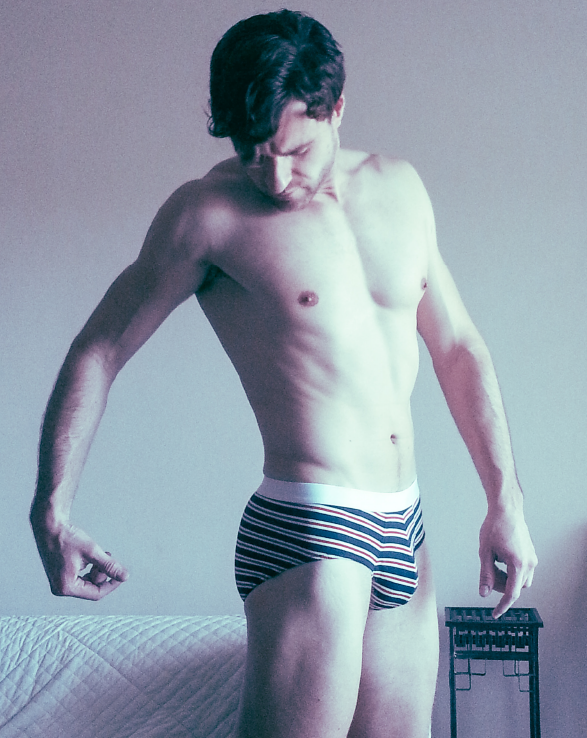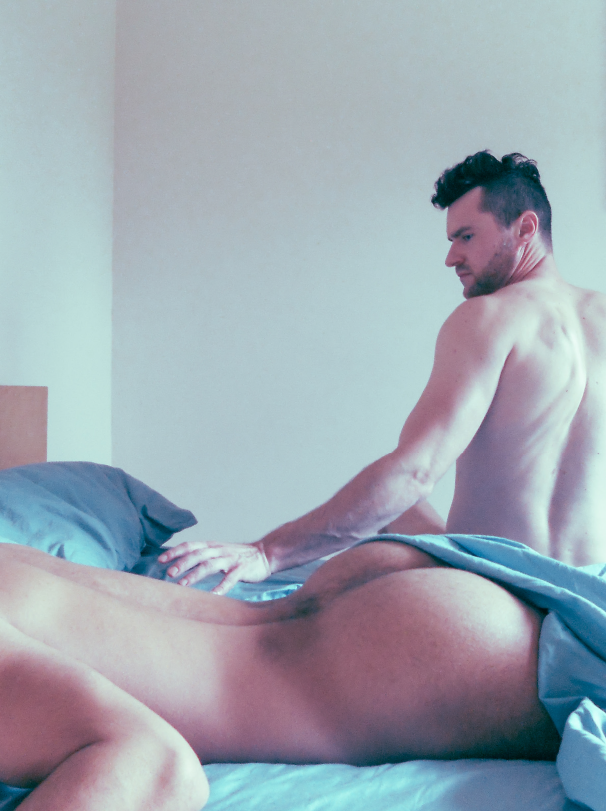
PHOTOGRAPHY BY BEN KLINE
Sex and Poetry with Ben Kline
The poet on his provocative Instagram and how to take bad advice
Early on in Ben Kline’s newest poetry collection, Going Fast in Loose Directions, a poem titled ‘A Minor Lament‘ opens with the following deceptively simple lines: “He unseated good sense. / The best lovers often do.” The declaration is purposefully economical, shortened to a mere nine words in order to speak in the simplest of terms to experiences of love and loss, desire and mania, sex and loneliness. Kline is adept at this trick of economy; none of the eighty poems that make up Going Fast in Loose Directions surpass two pages, and yet not a single one lacks for emotional depth or shrewd observation. Take the numbered sequences that recur under the titles ‘Propositions‘ and ‘Men I Know.’ Depicting blunt sexual advances in haiku form and ended relationships in free verse respectively, the numbered poems feel like interludes: sometimes steamy, sometimes heartbreaking, but always loaded with infinite possibility for what comes next.
It’s that sense of giddy unpredictability that makes Going Fast in Loose Directions, Kline’s first full collection to be published by Johnny Murdoc’s erotica micro-pub Queer Young Cowboys, so invigorating to read in the first place. Over the course of eighty poems, Ohio-native Kline offers readers a candid look at sex and love, detailing intense erotic encounters and damaging break-ups with matching elegance. Some of the poems, including the ‘Propositions‘ and ‘Men I Know‘ sequences, are culled from Kline’s Tumblr, Original Content Required, which serves as a public forum for writing exercises and selfies alike. His Instagram, too, is a testament to the author’s penchant for photos of himself, but the habit is far from obnoxious — if any working writer today has mastered the art of taking a dashingly handsome selfie, it’s Kline, no questions asked.
We dropped the author a line to ask him a few questions about Going Fast in Loose Directions, receiving bad advice from his creative writing teacher, and what he really thinks about the current state of poetry.
Where are you living right now? What do you do for work besides writing poetry? Cincinnati, Ohio. I work in a university library system, though what I do is in flux this summer during some reorganization.
When and how did you start writing poetry? I began writing during the summer of 1989, while still on the family farm, a junior gay in overalls with too much pent up frustration, dreaming of skyscrapers and art shows. I wrote mostly fiction, a few awful poems. Real poetry manifested in college, at the encouragement of fellow creatives in various writing classes and pals amused by my penchant for freestyling new (and funny) lyrics to almost any song.
What was the last event in your life that inspired you to write? My 40th birthday on May 27.
How long have you been working on this collection? Specifically, since May 2013. Spiritually, since 1994, after my 40something straight white male Creative Writing teacher told me that I write about sex and sexual matters far more than is polite.
What do perfect writing conditions look like for you? After 11:30pm, good downbeat music playing with the bass up, a whiskey ginger ale on the rocks, notepads and laptop at the ready.
The poems within the collection that form numbered sequences (‘Propositions’, ‘Men I Know’, etc.) struck me the most. Given the breadth of the collection, can you tell me about the creative process behind including these sequences? Both the Proposition haiku and the Men I Know poems are series from my blog, Original Content Required. I like the idea of thematic series of poems, either as a capsule body of work or as an ongoing theme. I wanted to include them in the book as a nod to my blog, where much of the work in Going Fast in Loose Directions was born. On the blog, the Propositions usually have complementary visual or audio elements, and I completed the #1 – #100 last month. The Men I Know poems were suggested by a friend, on the idea of going through one’s catalog of lovers and telling tales. I selected pieces from the series based on how I felt they meshed with the other work in the book.
As a working poet, what do you think is the current climate for poetry, or more specifically, queer poetry? How do you see yourself within this climate? For both poetry and queer poetry, the internet has broadened the field. When I was in my early 20s, I bought and studied Writer’s Market. I read Writer’s Digest. I submitted to all the big magazines and journals, to even more small presses and zines. I had a few bylines, including my first paid story at age 20. But it was a long road to maybe. Especially if you did not live in a large city, and your subject matter was gayer than a bathhouse orgy cast by Chi Chi LaRue. Now, young writers, actually all writers, have more avenues through which to create, develop, share, publish, market and… engage their work. Engagement is the biggest advance. The access to readers, fellow writers, like minds. It’s of utmost importance. Meanwhile I see myself as being part of the new and previous paradigms. I have a blog. I’m not afraid of carefully manipulated selfies. I will email a fellow creative without hesitation. Yet I remember gay and all that meant before the internet. I remember visiting Columbus, Ohio and going to my first gay bookstore in the early 90s. Neither set of conditions is better/worse. They simply were/are. A smart writer operates in the what is.
Most of Going Fast in Loose Directions focuses on erotic content while still remaining very emotionally open. How do you strike a balance between these different aspects of your romantic life when transforming them into art? Well… I always tell my friends: the poem is of me, but not about me. Which means I easily navigate that balance. Which sounds very clinical, but I am a terrible memoirist and no fan of biographical criticism. My life is not nearly as exciting as the poems might imply. When writing poems of an erotic or sexualized nature, I make a conscious effort to have even the most crass or explicit moment be emotionally accessible. I have work that tilts in other and more specific directions, but my Gemini nature is fascinated by the dualities, especially those surrounding sex and love.
Can you describe your editing process? When does a poem feel complete to you? I edit my poetry by reading it aloud. It has to sound a certain way for me to like it. I will record myself reciting it and listen carefully. I never feel a poem is complete. Even after it is published, which was the case with the title poem of the book.
The photography included in Going Fast in Loose Directions feels almost as intimate as the poetry itself. How did those photos come to be included in the book? Early in the bookmaking process, Johnny Murdoc and I discussed incorporating photography into the book. He fretted the technical design aspects. I concerned myself with the mood any photography might lend. As mentioned, I’m not afraid of a selfie. On my blog I enjoy writing poems over photos that either inspired or work with the words, especially when contemplating our modern digital lives. I also enjoy photography and was a photo studio apprentice in high school. I took all but one of the photos in the book, including the cover shot.
What are you reading at the moment? A few things: Percival Everett by Virgil Russell. I love Everett’s work. He is probably my favorite contemporary American writer. 3 Sections by Vijay Seshadri. The Collected Poems of Audre Lorde. Some mid 1980s issues of Uncanny X-Men.
What artists inspire your work, writers or otherwise? Percival Everett, Madonna, Jeanette Winterson, Robert Mapplethorpe, Milan Kundera, Anne Sexton, Louis Armstrong, Audre Lorde, T.S. Eliot, Chris Claremont, Keith Haring, Björk, Damien Hirst, Cindy Sherman, Aldo Balding, Edmund White, and many more. Those are the “big names” I can think of immediately.
On your publisher’s site, your Instagram is referenced as a “self-built altar to [your] body.” Can you respond to this? That is quite a pitch, yeah? I had a typical Instagram account — random selfies, food photos, nature snapshots, etc. — until early 2013, when I decided to re-engage my writing and my relationship with it. I decided to use my Instagram as a provocation/titillation/marketing workshop/playground. I wanted to drive traffic to my blog and play up certain aspects of my work. It’s as much a character as is “The Author” on my blog. It was a conscious decision and a curated effort that continues, though post-Going Fast in Loose Directions and its release, I’ve been considering another reconfiguration. However, I don’t take it as seriously as the above sounds. If the readers/viewers and I are enjoying the experience, that matters most.
You can buy Going Fast in Loose Directions at Queer Young Cowboys now. You can also follow Ben on Tumblr and Instagram.
